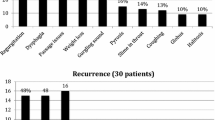Abstract
Background
Open surgical cricopharyngeal myotomy(CM) is considered standard of care for Zenker’s diverticulum(ZD). Trans-oral CM has been described using a rigid stapling device for two decades; however, this remains problematic for severely kyphotic patients. This problem can be overcome with flexible endoscopy utilizing an electrosurgical needle knife. We sought to compare clinical outcomes between these techniques to stratify patient selection.
Methods
Patients undergoing ZD treatment from 1992 to 2015 were reviewed. Demographics, diverticulum size, post-operative complications, and length of stay (LOS) were compared between open cricopharyngeal myotomy (OpenCM), rigid trans-oral stapling myotomy (RigidCM), and flexible endoscopic myotomy (FlexCM). Dysphagia scores (DS, 0:best-4:worst) and pneumonia incidence were assessed pre-operatively and post-operatively.
Results
62 patients underwent OpenCM (39/62(63 %)) or endoscopic CM (23/62(37 %) (8 RigidCM/15 FlexCM)). CM significantly reduced dysphagia for all approaches [OpenCM:2(2-3)-0(0-0); RigidCM:2(2-2)-0(0-0); FlexCM:3(3-3)-0(0-0)]. FlexCM patients had significantly worse pre-operative DS. Endoscopic CM was attempted and completed in 23/35(66 %) patients. Reasons for OpenCM conversion included inability to position the diverticular retractor due to patient body habitus (RigidCM), and the inability to position the overtube due to small ZD (FlexCM). Major post-operative complications were rare and similar in all groups. Medium-to-long-term post-myotomy pneumonia was comparable between groups. LOS (days) was reduced for FlexCM (1(1-2)) versus RigidCM (3(2-6)) and OpenCM (4(3-7)).
Conclusions
CM is highly effective for treating ZD. Open and endoscopic approaches offer comparable outcomes and dysphagia resolution. FlexCM is efficacious for large ZD and can be performed in most patients irrespective of body habitus. FlexCM represents an excellent approach for large ZD, while OpenCM should be reserved for small ZD for which an overtube cannot be positioned.


Similar content being viewed by others
References
Siddiq MA, Sood S, Strachan D (2001) Pharyngeal pouch (Zenker’s diverticulum). Postgrad Med J 77(910):506–511
Siddiq MA, Sood S (2004) Current management in pharyngeal pouch surgery by UK otorhinolaryngologists. Ann R Coll Surg Engl 86(4):247–252
Maran AG, Wilson J, Al Muhanna A (1986) Pharyngeal diverticula. Clin Otolaryngol Allied Sci 11(4):219–225
Klockars T, Sihvo E, Makitie A (2008) Familial Zenker’s diverticulum. Acta Otolaryngol 128(9):1034–1036
Sen P, Kumar G, Bhattacharyya A (2006) Pharyngeal pouch: associations and complications. Eur Arch Otorhinolaryngol 263(5):463–468
Leibowitz JM, Fundakowski CE, Abouyared M et al (2014) Surgical techniques for Zenker’s Diverticulum: a comparative analysis. Otolaryngol Head Neck Surg 151(1):52–58
Cook IJ, Gabb M, Panagopoulos V et al (1992) Pharyngeal (Zenker’s) diverticulum is a disorder of upper esophageal sphincter opening. Gastroenterology 103(4):1229–1235
Cook IJ, Blumbergs P, Cash K et al (1992) Structural abnormalities of the cricopharyngeus muscle in patients with pharyngeal (Zenker’s) diverticulum. J Gastroenterol Hepatol 7(6):556–562
Bizzotto A, Iacopini F, Landi R et al (2013) Zenker’s diverticulum: exploring treatment options. Acta Otorhinolaryngol Ital 33(4):219–229
Laing MR, Murthy P, Ah-See KW et al (1995) Surgery for pharyngeal pouch: audit of management with short- and long-term follow-up. J R Coll Surg Edinb 40(5):315–318
Feeley MA, Righi PD, Weisberger EC et al (1999) Zenker’s diverticulum: analysis of surgical complications from diverticulectomy and cricopharyngeal myotomy. Laryngoscope 109(6):858–861
Aggerholm K, Illum P (1990) Surgical treatment of Zenker’s diverticulum. J Laryngol Otol 104(4):312–314
Dzeletovic I, Ekbom D, Baron T (2012) Flexible endoscopic and surgical management of Zenker’s diverticulum. Expert Rev Gastroenterol Hepatol 6(4):449–465 quiz 466
Collard JM, Otte JB, Kestens PJ (1993) Endoscopic stapling technique of esophagodiverticulostomy for Zenker’s diverticulum. Ann Thorac Surg 56(3):573–576
Mulder CJ, den Hartog G, Robijn RJ et al (1995) Flexible endoscopic treatment of Zenker’s diverticulum: a new approach. Endoscopy 27(6):438–442
Bergquist H, Wenger U, Johnsson E et al (2005) Stent insertion or endoluminal brachytherapy as palliation of patients with advanced cancer of the esophagus and gastroesophageal junction. Results of a randomized, controlled clinical trial. ISDE 18(3):131–139
Bonavina L, Rottoli M, Bona D et al (2012) Transoral stapling for Zenker diverticulum: effect of the traction suture-assisted technique on long-term outcomes. Surg Endosc 26(10):2856–2861
Yuan Y, Zhao YF, Hu Y et al (2013) Surgical treatment of Zenker’s diverticulum. Dig Surg 30(3):207–218
Chiari C, Yeganehfar W, Scharitzer M et al (2003) Significant symptomatic relief after transoral endoscopic staple-assisted treatment of Zenker’s diverticulum. Surg Endosc 17(4):596–600
Rizzetto C, Zaninotto G, Costantini M et al (2008) Zenker’s diverticula: feasibility of a tailored approach based on diverticulum size. J Gastrointest Surg 12(12):2057–2064
Gutschow CA, Hamoir M, Rombaux P et al (2002) Management of pharyngoesophageal (Zenker’s) diverticulum: which technique? Ann Thorac Surg 74(5):1677–1682
Baldo V, Cocchio S, Baldovin T et al (2014) A population-based study on the impact of hospitalization for pneumonia in different age groups. BMC Infect Dis 14(1):485
Acknowledgments
The authors thank Mara Leimanis for assisting with data collection. There was no organizational or external financial support for this study.
Author information
Authors and Affiliations
Corresponding author
Ethics declarations
Conflict of interest
None of the authors have financial interest in the products, procedures, or devices presented in the manuscript.
Rights and permissions
About this article
Cite this article
Jones, D., Aloraini, A., Gowing, S. et al. Evolving Management of Zenker’s Diverticulum in the Endoscopic Era: A North American Experience. World J Surg 40, 1390–1396 (2016). https://doi.org/10.1007/s00268-016-3442-0
Published:
Issue Date:
DOI: https://doi.org/10.1007/s00268-016-3442-0




